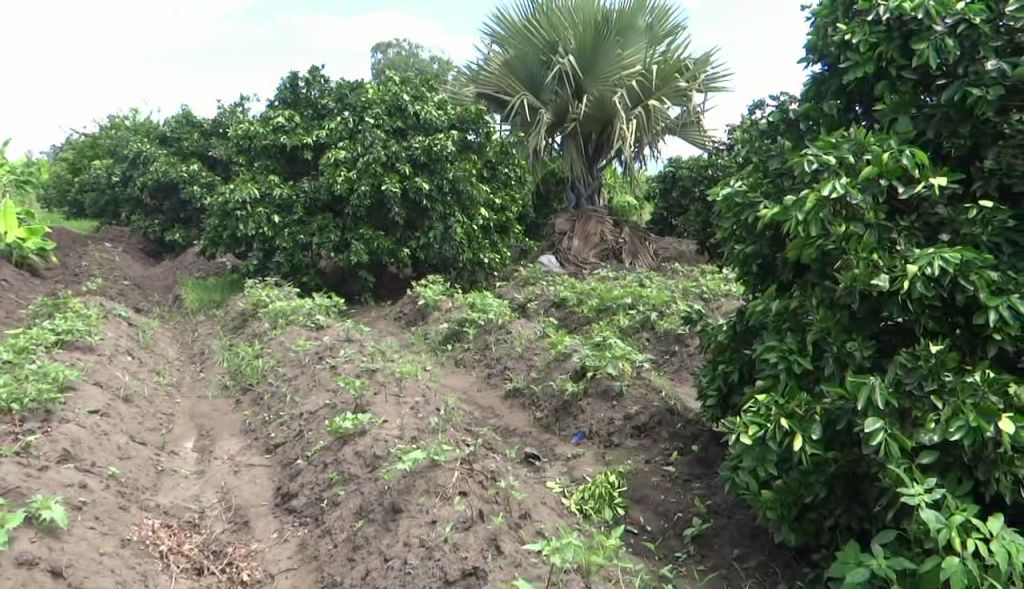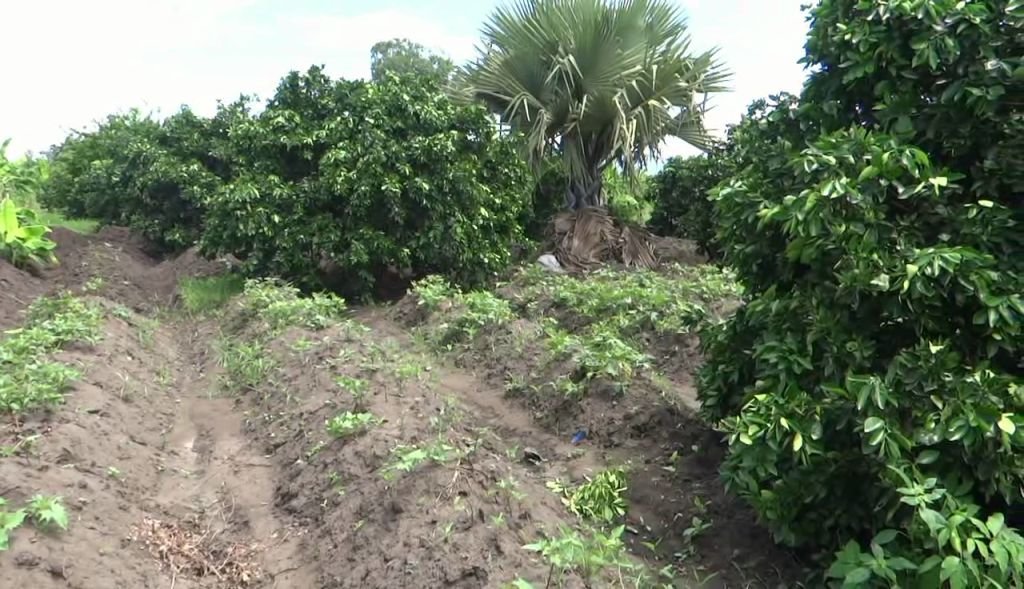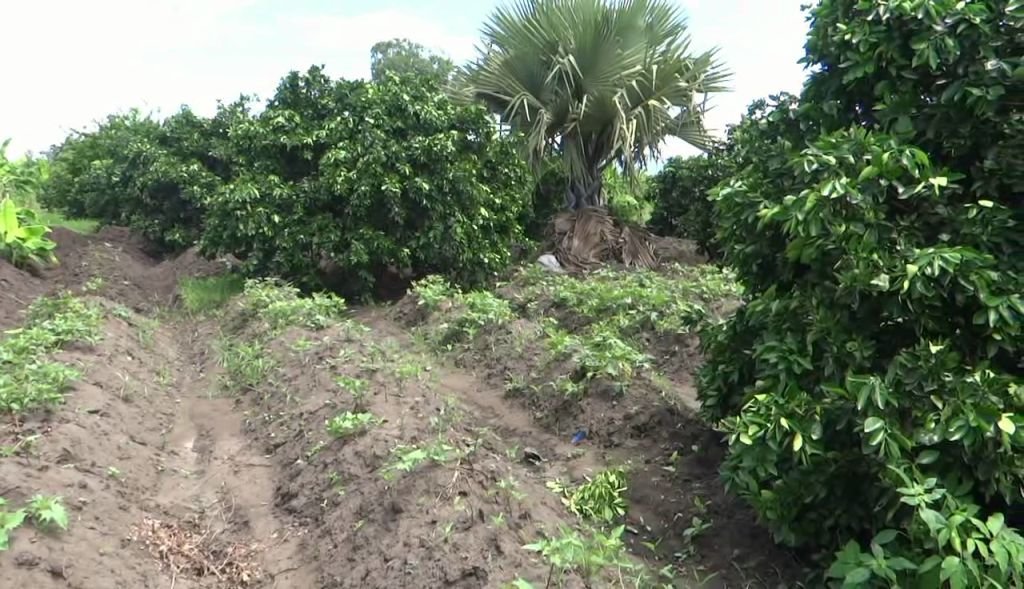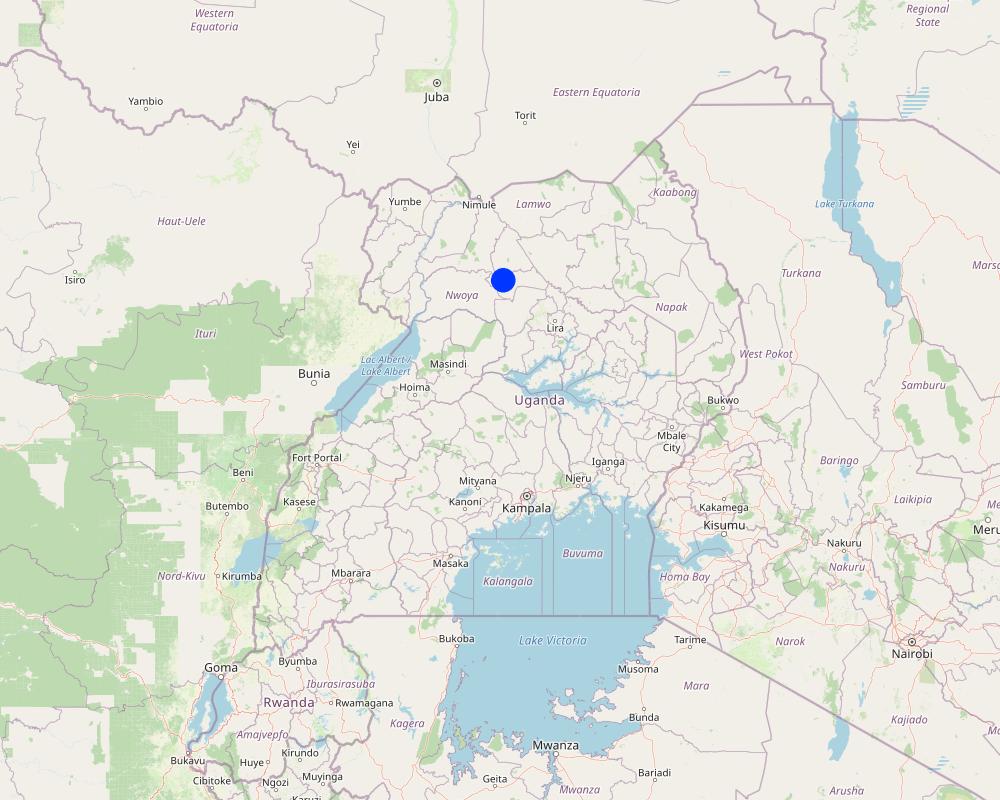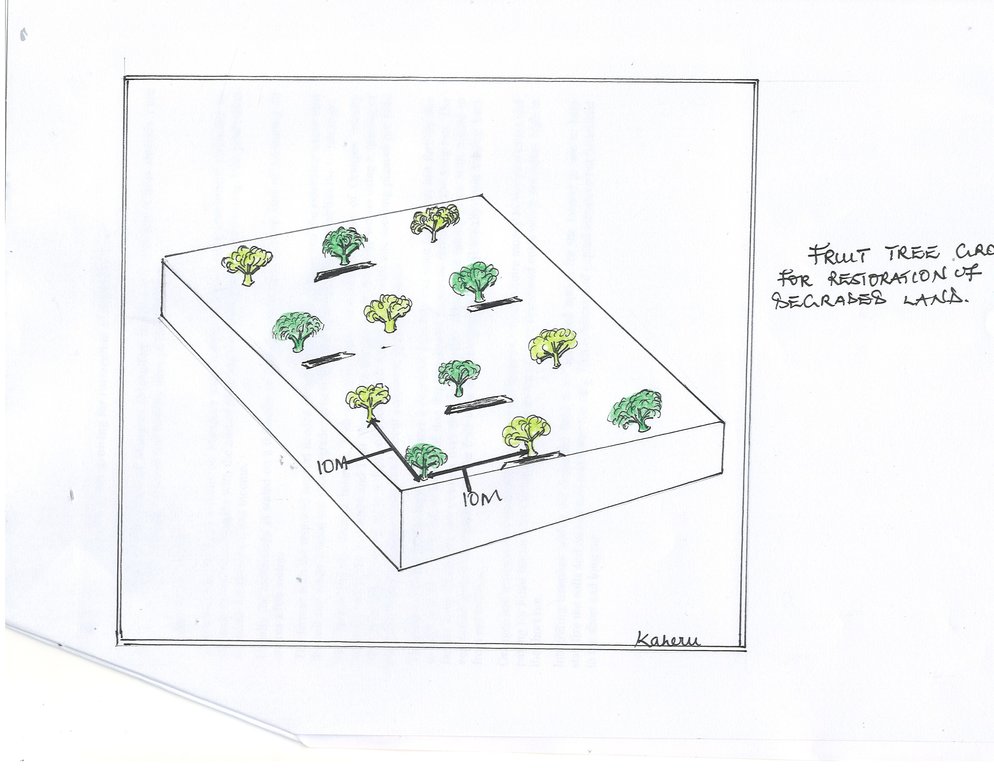Fruit tree growing for restoration of degraded lands [Uganda]
- Creation:
- Update:
- Compiler: Kamugisha Rick Nelson
- Editors: JOY TUKAHIRWA, Richard Otto Kawawa, Sunday Balla Amale, Bernard Fungo
- Reviewers: Donia Mühlematter, Drake Mubiru, Nicole Harari, Renate Fleiner, Stephanie Jaquet, Joana Eichenberger
technologies_2821 - Uganda
View sections
Expand all Collapse all1. General information
1.2 Contact details of resource persons and institutions involved in the assessment and documentation of the Technology
Key resource person(s)
land user:
Acen Constance
Name of project which facilitated the documentation/ evaluation of the Technology (if relevant)
Scaling-up SLM practices by smallholder farmers (IFAD)Name of the institution(s) which facilitated the documentation/ evaluation of the Technology (if relevant)
CDE Centre for Development and Environment (CDE Centre for Development and Environment) - Switzerland1.3 Conditions regarding the use of data documented through WOCAT
The compiler and key resource person(s) accept the conditions regarding the use of data documented through WOCAT:
Yes
1.4 Declaration on sustainability of the described Technology
Is the Technology described here problematic with regard to land degradation, so that it cannot be declared a sustainable land management technology?
No
1.5 Reference to Questionnaire(s) on SLM Approaches (documented using WOCAT)
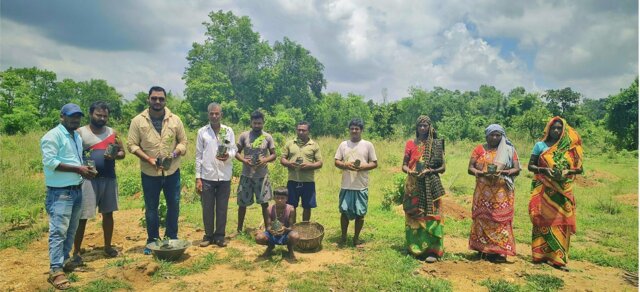
Community-led participatory and self sustainable land restoration in … [India]
A community-led participatory approach is being implemented in West Bengal to revive and regenerate a broken and degraded landscape through sustainable land management. Local people take the lead in both action and the development of a long-term management plan.
- Compiler: DIYA BANERJEE
2. Description of the SLM Technology
2.1 Short description of the Technology
Definition of the Technology:
Fruit trees of Mangoes (Mangifera indica) and Oranges (Citrus sinensis) are grown on degraded land to improve soil fertility through deep soil nutrient mining and litter of leaves.
2.2 Detailed description of the Technology
Description:
Fruit tree growing, with focus on mangoes and oranges, is a rewarding investment promoted by farmers in Northern Uganda with the aim of increasing fruit production for home consumption and income, and restoration of degraded land. On a farm located on a steep slope and measuring 40m x 100m (i.e. 1 acre), the land user select and plant disease tolerant, high yielding and marketable orange varieties (e.g. Valencia and Anlin) and mango varieties (Apple and Tommy) using spades, hoes, and pangas to excavate and dig up planting holes, 30 cm deep, with fruit trees planted at a spacing of 10 m ×10 m, during the rainy season; with 7 Cows, 5 goats and 4 sheep kept animal manure provision to apply on the technology using hired labour and supported by family labour. After establishment, the farmer keeps on observing the changes over time to see what is taking place with regard to vegetation growth, performance of fruit trees and how the visible soil properties are changing e.g. the colour showing a black sign of organic matter built up and soil health improvement.
Oranges and mangoes are susceptible to pests and diseases, which require money to buy pesticides and paying, as well as for hired labour for spraying. The farmer needs to be aware of these associated costs, which are rather high after establishment. Efforts by the farmer to integrate trenches within the degraded field is an additional option for the farmer to help enhance soil and water conservation by reducing water runoff. This is labour and capital intensive but beneficial in the short and long run.
2.3 Photos of the Technology
2.4 Videos of the Technology
Comments, short description:
Fruit tree growing for soil and water conservation in Amuru district.
Date:
15/12/2017
Location:
Amuru district, Northern Uganda
Name of videographer:
Issa Kasozi and Mark
2.5 Country/ region/ locations where the Technology has been applied and which are covered by this assessment
Country:
Uganda
Region/ State/ Province:
Northern Region,Uganda
Further specification of location:
Gulu District
Specify the spread of the Technology:
- evenly spread over an area
If precise area is not known, indicate approximate area covered:
- < 0.1 km2 (10 ha)
Map
×2.6 Date of implementation
Indicate year of implementation:
2015
If precise year is not known, indicate approximate date:
- less than 10 years ago (recently)
2.7 Introduction of the Technology
Specify how the Technology was introduced:
- through land users' innovation
- through projects/ external interventions
Comments (type of project, etc.):
It was supported by the extension worker with advisory services on how to plant and space.
3. Classification of the SLM Technology
3.1 Main purpose(s) of the Technology
- improve production
- reduce, prevent, restore land degradation
- create beneficial economic impact
3.4 Water supply
Water supply for the land on which the Technology is applied:
- rainfed
3.5 SLM group to which the Technology belongs
- integrated crop-livestock management
- improved plant varieties/ animal breeds
3.6 SLM measures comprising the Technology

agronomic measures
- A1: Vegetation/ soil cover
- A2: Organic matter/ soil fertility
- A5: Seed management, improved varieties

vegetative measures
- V1: Tree and shrub cover

structural measures
- S11: Others

management measures
- M1: Change of land use type
- M2: Change of management/ intensity level
- M3: Layout according to natural and human environment
- M6: Waste management (recycling, re-use or reduce)
Comments:
S11: Trenshes.
3.7 Main types of land degradation addressed by the Technology

soil erosion by water
- Wt: loss of topsoil/ surface erosion
- Wg: gully erosion/ gullying

soil erosion by wind
- Et: loss of topsoil
- Ed: deflation and deposition

chemical soil deterioration
- Cn: fertility decline and reduced organic matter content (not caused by erosion)

biological degradation
- Bc: reduction of vegetation cover
- Bh: loss of habitats
- Bq: quantity/ biomass decline
- Bs: quality and species composition/ diversity decline
3.8 Prevention, reduction, or restoration of land degradation
Specify the goal of the Technology with regard to land degradation:
- prevent land degradation
- restore/ rehabilitate severely degraded land
4. Technical specifications, implementation activities, inputs, and costs
4.1 Technical drawing of the Technology
4.2 General information regarding the calculation of inputs and costs
Specify how costs and inputs were calculated:
- per Technology area
Indicate size and area unit:
0.5 acres
other/ national currency (specify):
UGX
If relevant, indicate exchange rate from USD to local currency (e.g. 1 USD = 79.9 Brazilian Real): 1 USD =:
3400.0
Indicate average wage cost of hired labour per day:
5000
4.3 Establishment activities
| Activity | Timing (season) | |
|---|---|---|
| 1. | Site selection/ degraded area | Once before planting / during dry season |
| 2. | Look for required labour and in puts | Once before planting /during dry season |
| 3. | Select nutrient fixing, high yiedling and marketable varieties | Once before planting / during dry season |
| 4. | Transport the varieties to the field | On set of rains |
| 5. | Diging the holes | On set of rains |
| 6. | Planting using labour | During rainy season |
| 7. | Watering in case of drought. | During the dry season |
4.4 Costs and inputs needed for establishment
| Specify input | Unit | Quantity | Costs per Unit | Total costs per input | % of costs borne by land users | |
|---|---|---|---|---|---|---|
| Labour | persons days / monthly basis | Persons | 5.0 | 150000.0 | 750000.0 | 99.0 |
| Equipment | Hoe | Pieces | 5.0 | 10000.0 | 50000.0 | 100.0 |
| Equipment | Pangas | Pieces | 3.0 | 7000.0 | 21000.0 | 100.0 |
| Equipment | watering can | Pieces | 2.0 | 5000.0 | 10000.0 | 100.0 |
| Plant material | Seedlings | kgs | 1000.0 | 2500.0 | 2500000.0 | 100.0 |
| Other | Transport for seedlings | Lorry | 2.0 | 100000.0 | 200000.0 | |
| Total costs for establishment of the Technology | 3531000.0 | |||||
| Total costs for establishment of the Technology in USD | 1038.53 | |||||
Comments:
More costs on seedlings during establishment.
4.5 Maintenance/ recurrent activities
| Activity | Timing/ frequency | |
|---|---|---|
| 1. | Watering | Daily, dry season |
| 2. | Weeding | Twice a year, wet and dry season |
4.6 Costs and inputs needed for maintenance/ recurrent activities (per year)
| Specify input | Unit | Quantity | Costs per Unit | Total costs per input | % of costs borne by land users | |
|---|---|---|---|---|---|---|
| Labour | Labour for watering (monthly) | persons | 2.0 | 150000.0 | 300000.0 | 100.0 |
| Labour | Labour for weeding (monthly) | persons | 2.0 | 150000.0 | 300000.0 | 100.0 |
| Total costs for maintenance of the Technology | 600000.0 | |||||
| Total costs for maintenance of the Technology in USD | 176.47 | |||||
4.7 Most important factors affecting the costs
Describe the most determinate factors affecting the costs:
Labour for planting , weeding and watering on monthly basis.
5. Natural and human environment
5.1 Climate
Annual rainfall
- < 250 mm
- 251-500 mm
- 501-750 mm
- 751-1,000 mm
- 1,001-1,500 mm
- 1,501-2,000 mm
- 2,001-3,000 mm
- 3,001-4,000 mm
- > 4,000 mm
Specify average annual rainfall (if known), in mm:
1500.00
Specifications/ comments on rainfall:
Two rainy and two dry seasons - Bimodal rainfall.
Agro-climatic zone
- sub-humid
5.2 Topography
Slopes on average:
- flat (0-2%)
- gentle (3-5%)
- moderate (6-10%)
- rolling (11-15%)
- hilly (16-30%)
- steep (31-60%)
- very steep (>60%)
Landforms:
- plateau/plains
- ridges
- mountain slopes
- hill slopes
- footslopes
- valley floors
Altitudinal zone:
- 0-100 m a.s.l.
- 101-500 m a.s.l.
- 501-1,000 m a.s.l.
- 1,001-1,500 m a.s.l.
- 1,501-2,000 m a.s.l.
- 2,001-2,500 m a.s.l.
- 2,501-3,000 m a.s.l.
- 3,001-4,000 m a.s.l.
- > 4,000 m a.s.l.
Indicate if the Technology is specifically applied in:
- convex situations
5.3 Soils
Soil depth on average:
- very shallow (0-20 cm)
- shallow (21-50 cm)
- moderately deep (51-80 cm)
- deep (81-120 cm)
- very deep (> 120 cm)
Soil texture (topsoil):
- medium (loamy, silty)
Soil texture (> 20 cm below surface):
- medium (loamy, silty)
Topsoil organic matter:
- medium (1-3%)
5.4 Water availability and quality
Ground water table:
< 5 m
Availability of surface water:
medium
Water quality (untreated):
poor drinking water (treatment required)
Is water salinity a problem?
No
Is flooding of the area occurring?
No
5.5 Biodiversity
Species diversity:
- low
Habitat diversity:
- low
5.6 Characteristics of land users applying the Technology
Sedentary or nomadic:
- Sedentary
Market orientation of production system:
- mixed (subsistence/ commercial)
Off-farm income:
- 10-50% of all income
Relative level of wealth:
- average
Individuals or groups:
- individual/ household
Level of mechanization:
- manual work
Gender:
- women
- men
Age of land users:
- youth
- middle-aged
Indicate other relevant characteristics of the land users:
The land user is a secondary school teacher as a source of livelihood.
5.7 Average area of land used by land users applying the Technology
- < 0.5 ha
- 0.5-1 ha
- 1-2 ha
- 2-5 ha
- 5-15 ha
- 15-50 ha
- 50-100 ha
- 100-500 ha
- 500-1,000 ha
- 1,000-10,000 ha
- > 10,000 ha
Is this considered small-, medium- or large-scale (referring to local context)?
- small-scale
Comments:
0.5 acres of land not planted all due to the high cost of seeds and labour.
5.8 Land ownership, land use rights, and water use rights
Land ownership:
- individual, not titled
Land use rights:
- individual
Water use rights:
- individual
Comments:
Bought the land using a loan that he acquired from the bank.
5.9 Access to services and infrastructure
health:
- poor
- moderate
- good
education:
- poor
- moderate
- good
technical assistance:
- poor
- moderate
- good
employment (e.g. off-farm):
- poor
- moderate
- good
markets:
- poor
- moderate
- good
energy:
- poor
- moderate
- good
roads and transport:
- poor
- moderate
- good
drinking water and sanitation:
- poor
- moderate
- good
financial services:
- poor
- moderate
- good
Security:
- poor
- moderate
- good
6. Impacts and concluding statements
6.1 On-site impacts the Technology has shown
Socio-economic impacts
Production
crop production
Comments/ specify:
From the sale of fruits.
crop quality
Comments/ specify:
Good due to litter / green leaves.
land management
Comments/ specify:
Use of fruit trees are good at restoring degraded areas.
Income and costs
expenses on agricultural inputs
Comments/ specify:
Purchase of hoes, pangas and spades.
farm income
Comments/ specify:
From the sale of fruits.
workload
Comments/ specify:
Watering and weeding.
Socio-cultural impacts
food security/ self-sufficiency
Comments/ specify:
Not yet harvested
SLM/ land degradation knowledge
Comments/ specify:
Trainings on fruit farming and management by extension agents and fellow farmers.
Ecological impacts
Soil
soil moisture
Comments/ specify:
Due to the grass covert that minimize the evapotranspiration.
soil cover
Comments/ specify:
No cultivation/ allow grass to grow.
soil loss
Comments/ specify:
Fruit trees stabilize the soils.
soil organic matter/ below ground C
Comments/ specify:
Due to the mulch decomposition.
Biodiversity: vegetation, animals
Vegetation cover
Comments/ specify:
Growing under the planted fruit trees.
6.3 Exposure and sensitivity of the Technology to gradual climate change and climate-related extremes/ disasters (as perceived by land users)
Gradual climate change
Gradual climate change
| Season | increase or decrease | How does the Technology cope with it? | |
|---|---|---|---|
| annual temperature | increase | well | |
| seasonal temperature | wet/ rainy season | increase | moderately |
| annual rainfall | decrease | well | |
| seasonal rainfall | wet/ rainy season | decrease | well |
Climate-related extremes (disasters)
Biological disasters
| How does the Technology cope with it? | |
|---|---|
| insect/ worm infestation | moderately |
6.4 Cost-benefit analysis
How do the benefits compare with the establishment costs (from land users’ perspective)?
Short-term returns:
slightly positive
Long-term returns:
very positive
How do the benefits compare with the maintenance/ recurrent costs (from land users' perspective)?
Short-term returns:
slightly negative
Long-term returns:
positive
Comments:
Slightly Negative: More costs on labour and inputs.
Very positive: Very positive returns in improving fertility due to leaves litter.
6.5 Adoption of the Technology
- 1-10%
If available, quantify (no. of households and/ or area covered):
5
Of all those who have adopted the Technology, how many did so spontaneously, i.e. without receiving any material incentives/ payments?
- 0-10%
6.6 Adaptation
Has the Technology been modified recently to adapt to changing conditions?
No
6.7 Strengths/ advantages/ opportunities of the Technology
| Strengths/ advantages/ opportunities in the land user’s view |
|---|
| Appropriate for both small and large scale land users. |
| Can be replicated and be promoted by other land users. |
| Cost effective: Invest in more money at the establishment and earn more benefits (restoration of degraded areas, income, soil fertility improvement, employment and fruits for home consumption and sale). |
| Strengths/ advantages/ opportunities in the compiler’s or other key resource person’s view |
|---|
| The technology is appreciated by the farmer and this is a sign of ownership - sustainability. |
6.8 Weaknesses/ disadvantages/ risks of the Technology and ways of overcoming them
| Weaknesses/ disadvantages/ risks in the land user’s view | How can they be overcome? |
|---|---|
| Very laborious (planting, wedding and watering). | Use family labour. |
| Very expensive - buying seedlings and hire of labour. | Join savings groups that give loans at low interest rates (3%). |
| Benefits are realized after a long period. | The land user can look for alternative sources of income to supplement the technology. Engage in selling seedlings as a business to those who may want to start establishing this technology. |
| Weaknesses/ disadvantages/ risks in the compiler’s or other key resource person’s view | How can they be overcome? |
|---|---|
| No integration with other agroforestry trees for fodder yet as the land user has livestock. | The technology need to be integrated with agroforestry trees (callindra, Grivellea ) for fodder since the land user has livestock. |
7. References and links
7.1 Methods/ sources of information
- field visits, field surveys
01
- interviews with land users
01
When were the data compiled (in the field)?
24/05/2017
Links and modules
Expand all Collapse allLinks

Community-led participatory and self sustainable land restoration in … [India]
A community-led participatory approach is being implemented in West Bengal to revive and regenerate a broken and degraded landscape through sustainable land management. Local people take the lead in both action and the development of a long-term management plan.
- Compiler: DIYA BANERJEE
Modules
No modules


